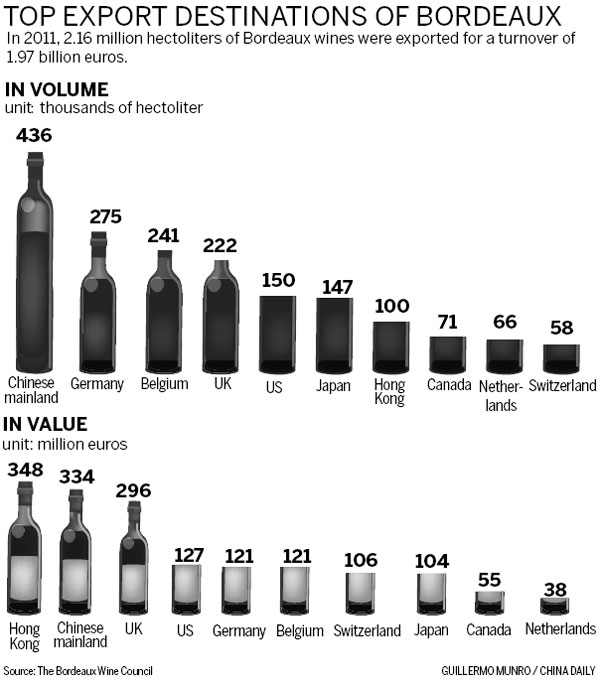Reds' star rises in the East
Updated: 2012-08-04 10:24
By Li Xiang (China Daily)
|
|||||||||||
|
 |
The main distribution channels for Bordeaux wines in China are private clubs and luxury five-star hotels where a 4-euro bottle of wine can be easily sold for 1,000 yuan ($157).
"The wide profit margin is definitely the major motivation behind the Chinese acquisitions, said Lin Lan, manager at real estate company EC Immobilier in France.
"Some Chinese buyers would look for chateaux that have a similar-sounding name to famous first-growth chateaux such as Lafite Rothschild, hoping to cash in on the 'Lafite effect' in the home market."
While wine producers and traders in Bordeaux are well aware of the risks of putting all their eggs in one basket, the temptation of the Chinese market is just too hard to resist.
Many top-tier chateaux in Bordeaux have already stepped up their promotional efforts in China, hoping to capitalize on China's surging interest in wine.
Hiring Chinese-speaking assistants, opening Chinese social media websites, designing labels that appeal to Chinese consumers, and organizing tasting events in China are common ways for French chateaux to attract Chinese buyers.
"You have to be there to build the brand. You have to show your face and your wines for a market that is very eager to learn and to taste different wines," says Anne Cuvelier, public relations officer for Chateau Leoville Poyferre, a second-growth chateau in the Medoc region.
The chateau is gathering ideas for a special promotion of a wine that it has adapted especially for the Chinese market.
"We want to make sure they understand the wine and the work behind it. It would be a pity if a bottle is opened just because it is expensive," she says.
So far, Chinese consumers have been buying either at the very top or the very bottom end of the Bordeaux range, as the main purpose of wine consumption is still predominantly based around entertaining and gift giving.
But the trend is gradually changing, as Chinese buyers become more knowledgeable and sophisticated about wines, reflected in the rapidly growing demand for mid-range wines.
"We don't expect three-digit growth to happen forever," said Georges Haushalter, president of CIVB.
"What is very interesting to notice in China now is that we actually have a growth rate higher in volume than in value, which shows that we are going from a position where people are looking at the most expensive wines as social trophies, to a position where more and more people actually drink wines themselves."
CIVB's president for Asia, Thomas Jullien, added: "We are seeing a turning point in the Chinese market where growth is likely to be slower.
"But we are comfortable with it because it means that people are starting to care about the long-term prospect of the market."
Diva Bordeaux's Rousseau said that the company has been selling mostly 2-euro wines or bottles costing more than 50 euros over the past two years.
But now wines priced between 4 to 10 euros from the Saint-Emilion and Graves areas are becoming increasingly popular among Chinese buyers.
"These wines are consumed by the middle class, who hold huge potential in China. And demand in the second- and third-tier cities has just begun to grow," he said.
"That's why we think, for a great part, the future of Bordeaux's wine market is in China."
lixiang@chinadaily.com.cn
Related Stories
French wine campaign to lure Chinese enthusiasts 2012-07-13 14:35
Alcohol drinks sales hit a high 2012-07-09 09:18
China unearths earliest wine in NW tomb 2012-07-06 11:24
Top wine demand falls in Asian 2012-06-11 10:22
China's wine investment market cools down 2012-05-14 16:05
Today's Top News
President Xi confident in recovery from quake
H7N9 update: 104 cases, 21 deaths
Telecom workers restore links
Coal mine blast kills 18 in Jilin
Intl scholarship puts China on the map
More bird flu patients discharged
Gold loses sheen, but still a safe bet
US 'turns blind eye to human rights'
Hot Topics
Lunar probe , China growth forecasts, Emission rules get tougher, China seen through 'colored lens', International board,
Editor's Picks

|

|

|

|

|

|





